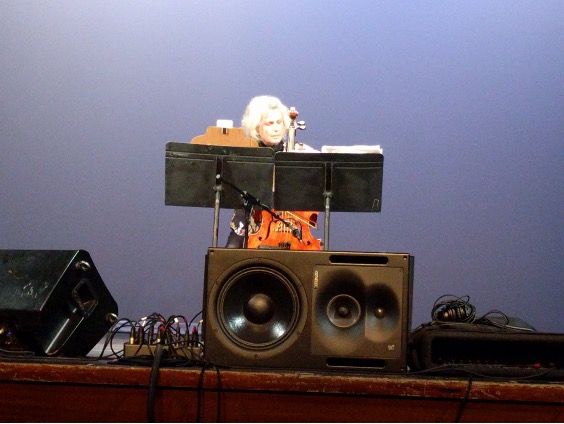“In the Bay II”
Fixed media and live electronics, for Cello and 7 channels surround sound (2017)
“In the Bay II” was selected for New York City Electroacoustic Music Festival 2017 and premiered on June 23, 2017, at New York City’s Abrons Arts Center. The cellist for this premiere performance was Madeleine Shapiro, and the piece’s length is 7 minutes and 7 seconds.
[excerpt]
[full]
[music only] (Not from this performance)
Since the sound from videos is not very good, I put an audio file here.
[Description and Score]
Please download the pdf file from the link below.
https://drive.google.com/file/d/1S5rJfOZ5nceVqmy00odwUhsvnm9_Tbat/view?usp=share_link
(Just in case the link does not work.)
- Introduction
“In the Bay II” uses a cello and live electronics, with a 7ch fixed media. “In the Bay II” builds on “In the Bay I” for 16-channel fixed media, in which I added a cello part. Thus, “In the Bay II” consists of “In the Bay I” plus a cello performance.
- Concept
Both “In the Bay” pieces were inspired by my visual memory of the bay I see every day. In the bay, the waves come and go -- gently and calmly, or roughly in stormy weather. The color of the water is different almost every time I observe it. The ocean is never still and is universal. I try to express these aspects of the waves (water) in my music. For “In the Bay II,” I wanted to add more colors/textures to the sound to enrich images of the bay in listeners’ imaginations, and to broaden my work’s horizons.
- Process
“In the Bay I” was composed for stereo sound at the beginning. First, I collected the sound materials, then chose what I wanted to use carefully. I thought about the structure of the song and edited the materials by using Logic Pro and Cecilia (audio-signal processing software). I found some sound materials from free sound libraries, and I also used some synthesizer sounds for musical parts that are not tied to the melody.
Finally, I put together all sound materials and synthesizer music, based on the structure and concept I chose: the state/movement of waves in the bay. After this process, I still needed to add more music and sound for adjustment, but this was how “In the Bay I” for stereo was created.
With this “In the Bay I” stereo version soon came the idea of adding a cello performance. I thought a cello sound would add more color and depth to the whole piece. After adding the cello part to the stereo version, I mixed all music into seven channels and examined how the live electronics should work, leading to the completion of “In the Bay II.”
- Musical Dimensions
As I mentioned above, a fixed-media dimension was created in advance. I used Logic Pro to create sound and music using pre-recorded and edited sound materials, synthesizers, and materials from sound libraries, such as the sounds of water, rowing a boat, and other noises.
The spatial effects also were carefully considered. Since this music was for surround-sound systems, I cared about the depth of music developed by seven speakers as I mixed. I believe that the depth and the spread of music/sound with seven speakers made my music more persuasive and expanded the quality of the work.
- Structure
The structure of “In the Bay” is based on wave-like movements (coming and
going) from ocean sounds. For the fixed-media dimension, it has an A-B-A structure.
A: It starts very quietly, with some vinyl noise sounds; the abstract-noise sounds surface gradually.
B: The synthesizer harmonies then appear, and the music gradually develops with other sound layers. It starts mezzo forte, then crescendos before the GP (general pause) point.
GP: This part is not complete silence, but has slight background sounds.
A’: After the silence, A starts again, with vinyl noises, and develops with other sounds. This time, you can hear a boat-rowing sound, creating the presence of water. In seven-channel and 16-channel mixings, this sound moves differently as the boat comes and goes. Finally, white noise (ocean-wave-like sounds) appears with a crescendo, then a decrescendo as the waves wipe everything out.
Cello:
(These squared alphabets are rehearsal numbers on the score below.)
A: With an Ordinary Bowing (melody)
B: Molto Sul Tasto/Sul Ponticello (left hand: trilling with harmonics)
C-E: Stopped Harmonics
F-K: Glissando
L: With an Ordinary Bowing (melody)
M-N: Stopped Harmonics
O: Molto Sul Tasto/Sul Ponticello (left hand: trilling with harmonics)
In all parts above, the cello sound moves up and down. For instance, in A, a note goes up and goes down (Figure 1). In F, you can see the movements, i.e., / \ / \, on the score (Figure 2).
Figure 1

Figure 2

- Stage Setup
Since there is only one cellist on the stage, a microphone was used. The microphone sound went through my audio interface and my computer, then went through the mixer to the speakers.
Here is a stage setting and speakers configuration.


(Speakers configuration)
 (The cellist Madeleine Shapiro played “In the Bay II” on the stage.)
(The cellist Madeleine Shapiro played “In the Bay II” on the stage.)
- Information
Title: “In the Bay II”
Composer/Producer/Mixing: Hanae Azuma
Cello: Madeleine Shapiro
Year: 2017 Duration: 7 minutes and 7 seconds